Equilibrium
Problem:
A 1500 kg automobile has a wheelbase (the distance between the axles) of 3 m.
The center of mass of the automobile is on the centerline at a point 1.2 m
behind the front axle. Find the force exerted by the ground on each wheel.
Solution:
- Concepts:
Static equilibrium
- Reasoning:
The car is in static equilibrium, Ftot
= 0, τtot = 0. The force of gravity Mg acts on the
center of mass of the object. It produces no torque about the CM.
- Details of the calculation:
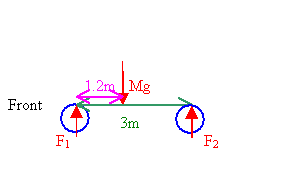
Ftot = F1 + F2 - Mg = 0.
τtot
= F2 1.8 m - F1 1.2 m = 0.
F1 = 1.5 F2.
2.5F2 = Mg = 14700 N, F2 = 5880 N. F1 =
8820 N.
The force exerted by the ground on each rear wheel is F2/2
= 2940 N and the force exerted by the ground on each front wheel is F½
= 4410 N.
Problem:
A board weighing 90 N and 12 m long rests on two supports with each support
being one meter from its respective ends. A 360 N block is placed on the
board 2 m from the rightmost support. Find the force that is exerted by each
support on the board.
Solution:
- Concepts:
Equilibrium
- Reasoning:
Equilibrium implies no net force and no net torque.
- Details of the calculation:
No net force:
Fleft + Fright
- mboard*g - mload*g = 0.
Fleft + Fright
= (90 + 360) N = 450 N.
No net torque about any point:
Choose the left
support point. Fright*10 m - mboard*g*5 m - mload*g*8
m = 0.
Fright = (90*5 + 360*8)/10 N = 333 N.
Fleft
= 117 N.
Both Fleft and
Fright point
upward.
Problem:
A uniform massive rod AB of length L rests at the inclination ±10o
with respect to the horizontal with end A in contact with a vertical wall.
The two configurations are shown in figures a and b. End of the rod is
supported by a massless cord BC, which is of length 1.2 L and is attached at C,
a point on the wall above A. What coefficient of static friction between A
and the wall is necessary to achieve each configuration?

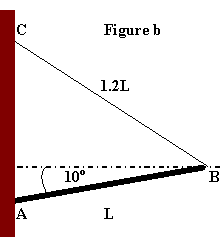
Solution:
- Concepts:
Static equilibrium, static friction: Fmax = μN,
N = normal force
- Reasoning:
In static equilibrium the total force and the total torque
about the CM must be zero. F = 0, τ = 0
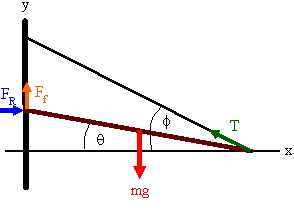
The diagram shows the forces on the rod. The forces acting at the ends of
the rod can exert a torque about the CM.
- Details of the calculation:
(i) Fy = Tsinφ + Ff
- mg = 0
(ii) Fx = -Tcosφ + FR = 0
(iii) τ =
(L/2)[Tsin(φ - θ) - Ff cosθ - FR sinθ] = 0
Note: Ff
could be positive or negative.
We have 3 equations and 3 unknowns. We
are, however, only interested in the ratio Ff/FR.
Inserting (ii) into (iii) we have
T sin(φ - θ) - Ff cosθ - T
cosφ sinθ = 0, Ff = [T sin(φ - θ) - T cosφ sinθ]/cosθ.
μ = |Ff|/N
= |Ff|/FR = Ff/(Tcosφ) = [sin(φ - θ) - cosφ
sinθ]/[cosφ cosθ].
cosφ = L cos10o/(1.2 L) = 0.82067.
φ =
34.848o.
case (a): θ = 10o, μ = 0.3436 or
greater.
case (b): θ = -10o, μ = 1.0489 or greater.
Problem:
A homogeneous ladder of length L leans against a wall (see figure). The
coefficient of friction with the ground is μ1, the coefficient of
friction with the wall is μ2. Find the minimal angle θ, below which
the ladder will slip.

Solution:
- Concepts:
Static equilibrium, static friction: Fmax = μN, N = normal force
- Reasoning:
In static equilibrium the total force and the total torque about the CM must
be zero. F = 0, τ = 0
- Details aof the calculations:
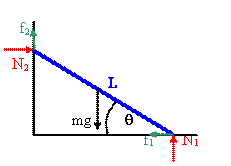
In equilibrium:
Fy = 0: N1 + f2 = mg (1)
Fx = 0: N2 = f1 (2)
The torque about the CM is zero: N2sinθ + f2cosθ
+ f1sinθ = N1cosθ (3)
(N2 + f1)sinθ = (N1 - f2)cosθ
(rewriting (3))
2f1sinθ = (mg - 2f2)cosθ (eliminating N1
and N2 from (3) using (1) and (2))
tanθ = (mg - 2f2)/(2f1)
The angle θ is smallest when both f1 and f2 have their
maximum value.
tanθ = (mg- 2μ2N2)/(2μ1N1) = (N1
+ μ2μ1N1- 2μ1μ2N1)/(2μ1N1)
= (1 - μ2μ1)/(2μ1).
For smaller angles the ladder will slip.
Problem:
A 5.0 m long ladder leans against a wall at a point 4.0 m above the ground.
The ladder is uniform and has a mass of 12.0 kg. Assume the wall is
frictionless, but the ground is not.
(a) Determine the forces exerted on the
ladder by the ground and the wall.
(b) If the coefficient of static friction
between the ladder and the ground is 0.40, how far up the ladder can a 58 kg
person climb before the ladder slips?
Solution:
- Concepts:
Static equilibrium: F = 0, τ = 0
- Reasoning:
In static equilibrium the total force and the total torque
about the CM must be zero.
- Details of the calculation:
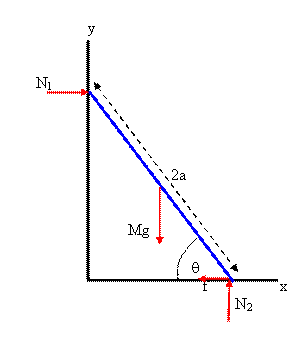
(a) Fx = N1 - f = 0. Fy = N2
-
Mg = 0. τ = N2 a cosθ - f a sinθ - N1 a sinθ = 0.
(about CM)
Mg 3/5 - f 4/5 - f 4/5 = 0. 3 Mg - 8 f = 0, f =
(3/8) Mg = 44.1
N.
The force exerted by the ground on the ladder is 117.6 N j -
44.1 N i, and the force exerted on the ladder by the wall is 44.1 N
i.
(b) With a person of mass m a distance on the ladder at a
distance a + d from the end on the ground we have
Fx = N1
- f = 0. Fy = N2 - Mg - mg = 0.
τ = N2
a cosθ + mg d cosθ - f a sinθ - N1 a sinθ = 0.
3(M +
m)g + 3mg(d/a) - 8f = 0. f = 3g(M + m (1 + (d/a))/8.
μ = f/N2
= 3(M + m (1 + (d/a))/[8(M + m)].
d/a = (8μ/3 - 1)(M + m)/m = 0.08.
d + a
= 2.7 m.
Problem:
A long thin uniform rod lies flat on the table as shown. One end of the rod
is slowly (quasi-statically) pulled up by a force that remains perpendicular to
the rod at all times. What minimum coefficient of static friction is required
so that the rod can be brought to the vertical position without any slipping of
the bottom end?
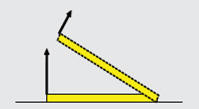
Solution:
- Concepts:
Static equilibrium
- Reasoning:
Since the rod is raised slowly (quasi-statically), the entire system remains
in equilibrium at any moment in time. Thus, the torque about the point of
rotation of the rod is zero, and the net external force is 0.
- Details of the calculation:

Assume that 0 < θ < π/2.
Ffri = Fsinθ, τ = -Fl + mglcosθ/2 = 0
--> F = mgcosθ/2,
N = mg - Fcosθ.
We need the coefficient of friction μ > Fsinθ /( mg - Fcosθ).
Eliminating F from the equation we have μ > sinθ cosθ/(2 - cos2θ).
Find the maximum μ as a function of angle from dμ/dθ = 0.
dμ/dθ = [(2 - cos2θ)(2cos2θ - 1) - 2cos2θ (1
- cos2θ)]/(2 - cos2θ)2 = 0
Since the denominator is finite the numerator has to be zero. Let x = cos2θ.
(2 - x)(2x - 1) - 2x(1 - x) = 0, x = (2/3), cosθ = (2/3)½, sinθ =
(1/3)½.
The coefficient of friction must be large enough to prevent slipping at that
angle.
μ > (1/3)½(2/3)½/(2 - (2/3)) = (1/8)½.
μmin = (1/8)½.
Problem:
Two steel balls, each of radius R and mass M, are packed into
a bottomless cylindrical thin-walled tube of diameter R(2 + √2). The tube and
balls sit on a table. There is no friction anywhere in the problem. Find the
minimum mass of the tube m that will keep the system in equilibrium.
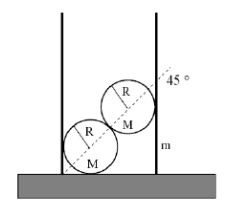
Solution:
- Concepts:
Static equilibrium
- Reasoning:
For the system to be in equilibrium the net force on and the net torque on
all components must be zero.
- Details of the calculation:

Consider the top ball. We need
Mg = Fn2/√2 and Fn1 = Fn2/√2. Therefore Fn1
= Mg, Fn2 = Mg/√2.
Consider the bottom ball. We need
Fn3 = Fn2/√2 and Mg + Fn2/√2 = Fn4.
Therefore Fn3 = Mg, Fn4 = 2Mg.
No torque is exerted on the balls.
The net force on the tube is zero.
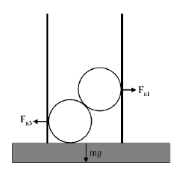
Let us calculate the net torque on the tube about the right lower edge in
the diagram. In equilibrium we need this torque to be zero.
The balls, pushing against the wall, and the weight of the cylinder exert a
torque about the right lower edge.
If the net torque due to these forces points out of the page, then the
reaction force from the ground on the left lower edge will cancel it, since
the cylinder cannot move into the ground.
For a cylinder with minimum mass m the torque due to the reaction force from
the ground is zero.
0 = Fn1 R(2 + √2) - Fn3R - mg R(2 + √2)/2.
Substituting we obtain
0 = M(1 + √2) - M - mg(1 + 1/√2), which yields the minimum mass of the tube,
m = 2M/(1 + √2).
Problem:
A uniform metal plate has mass m and length 4R. The plate is bent in half at
right angles and placed on a horizontal cylinder of radius R as shown.
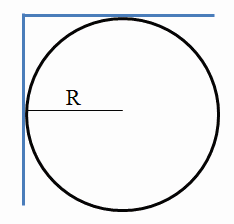
The top half of the plate is horizontal. The cylinder is fixed. What is the
minimum coefficient of static friction μs between the plate and the
cylinder
that allows the plate to remain at rest?
Solution:
- Concepts:
Equilibrium, free-body diagrams
- Reasoning:
Draw a free-body diagram that
shows all the forces that can act on the plate. In equilibrium the net
force and the net torque about any point have to be zero.
- Details of the calculation:
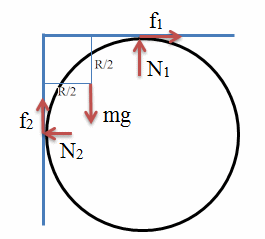
Force:
horizontal component: f1 = N2
vertical component: f2 + N1 = mg
We also have f1 ≤ μsN1, f2 ≤ μsN2.
torque about the corner:
mg*R/2 + N2*R = N1*R
Combining these equations we eliminate f2.
f1 + f2 = mg/2, f2 ≤ μsf1,
N1 = f1 + mg/2, f1 ≤ μs(f1
+ mg/2), f1 ≤ μs(mg/2)/(1 - μs).
But mg/2 ≤ f1 + μsf1, so
1 ≤ μs(1 + μs)/(1 - μs), μs2
+ 2μs - 1 ≥ 0.
The minimum μs satisfies μs2 + 2μs
- 1 = 0. μs(min) = 2½ - 1.
Problem:
A rope is wound around a cylinder of radius R with a contact angle φ
(φ can be larger than 2π) to hold a massive object in place, for example
to secure a ship for docking.
The object exerts a force F on one end of the rope and the other end
of the rope held by a force T. The coefficient of static friction
between the rope and the cylinder is k. Find the ratio F/T required
to keep the object stationary as a function of φ.

Solution:
- Concepts:
Equilibrium, friction
- Reasoning:
The frictional force is proportional to the normal force. We have to find the
normal force a small section of rope exerts on the cylinder.
- Details of the calculation:
Consider an
infinitesimally small section of rope of length Rdθ, acted on by the forces T'' = T'
+ dT' and T' as shown.
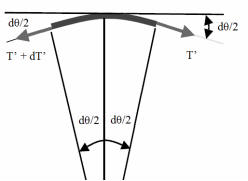
The magnitudes of the tangential and normal components of these forces are
T't = T'cos(dθ/2), T'n = T'sin(dθ/2), T''t =
T''cos(dθ/2), T''n = T''sin(dθ/2).
The magnitude of the net tangential force is T''t - T't =
dT'cos(dθ/2) = dT'.
The magnitude of the net normal force is N = (2T' + dT')sin(dθ/2) = T'dθ since
dθ is infinitesimal and we only keep first order terms in the small quantities.
For the section of rope to be in equilibrium, we need
|dT'| ≤ kN = kT'dθ
|dT'|/T' ≤ kdθ.
Assume we want to find the minimum
value of T. (T < F, dT' is positive.)
Integrating from θ = 0 to θ = φ we find ln (F/T) = -kφ, F/T = exp(-kφ).
To keep the object stationary we need F/T = exp(kφ),
T = Fexp(-kφ).
(Here we assume that φ is small enough so that friction
alone does not keep the object stationary.)
Problem:
A rope rests on two platforms which are both inclined at angle θ (which you
are free to pick) as shown. The rope has uniform density and its
coefficient of friction with the platform is 1. The system has left-right
symmetry. What is the largest possible fraction of the rope that does not
touch the platform? What angle θ allows this maximum value?

Solution:
- Concepts:
Static equilibrium
- Reasoning:
Let the total mass of the rope be m and let a fraction f
of it hang in the air. For each half of the symmetrical situation, the
weight of the hanging fraction must be balanced by the vertical component of
the tension in the rope. For the fraction of the rope touching the platform
the frictional force must balance the gravitational force component along
the plane plus the tension in the lower end.
For a given angle θ:
maximum frictional force --> maximum tension --> maximum hanging fraction
- Details of the calculation:
For the right half:
Hanging weight =
(f/2)mg. Vertical component of tension = T sinθ.
(f/2)mg = T sinθ. T
= (f/2)mg/sinθ.
Mass of rope touching platform = (1 - f)m/2. Normal
force = (1 - f)(m/2)g cosθ.
Maximum frictional force = (1 - f)(m/2)g
cosθ, since the coefficient of friction is 1.
Gravitational force
component along the plane = (1 - f)(m/2)g sinθ.
(1 - f)(m/2)g cosθ = (1 -
f)(m/2)g sinθ + (f/2)mg/sinθ.
f = (cosθ sinθ - sin2θ)/(1 +
cosθ sinθ - sin2θ). This can also be written as
f = (sin2θ +
cos2θ - 1)/(2 + sin2θ + cos2θ - 1).
To find the angle for which fmax(θ)
= fmax, set df/dθ = 0.
θmax = 22.5o. fmax
= (21/2 - 1)/(21/2 + 1) = 0.172.
Problem:
A floor has an area of 100 m2. Its consists of two very stiff
plates, separated by coil springs to give it some "bounce". The
equilibrium separation is 5 cm. There are 100 evenly spaced identical
springs per square meter. The spring constant of each spring is k = 103
N/m.
(a) Find the Young's modulus of this floor.
(b) When 20 people with a combine mass of 1200 kg rest on this floor (in
equilibrium), by
how much does the distance between the plates change?
(c) In (b), what is the elastic (strain) energy stored in the floor?
Solution:
- Concepts:
Young's modulus
- Reasoning:
The Young's modulus is defined through F/A = Y ΔL/L,
Y = (tensile
stress)/(tensile strain).
- Details of the calculation:
(a) The effective spring constant of the system of 104 springs
in parallel is 107 N/m.
Hooke's law: F/ΔL = k = YA/L = 107 N/m.
Y = (107 N/m)*(5*10-2 m)/100 m2 = 5*103
N/m2.
(b) ΔL = FL/(AY) = (1200 kg)*(9.8 m/s2)*(5*10-2
m)/(100 m2 * 5*103 N/m2) = 1.18 mm.
The distance between the plates change by 1.18 mm.
(c) We model the floor as a compressed spring. The spring constant k
= 107 N/m.
The elastic energy stored in the floor is ½k ΔL2 = 7 J.
Think about: Why not mgΔL?
















